12 Best Competitor Analysis Tools Free to Use in 2025
Staying ahead of your rivals requires a deep understanding of their strategies, strengths, and weaknesses. Understanding your competitors is a fundamental step in navigating the complex digital marketing landscape. The right intelligence allows you to identify market gaps, refine your value proposition, and anticipate their next move. However, comprehensive competitor analysis often comes with a hefty price tag, putting premium software out of reach for many startups, small businesses, and marketers on a tight budget.
Fortunately, a wealth of powerful competitor analysis tools free of charge are available, offering significant insights without the financial commitment. These platforms provide everything from website traffic estimates and keyword rankings to backlink profiles and the technology stacks your competitors are using. Knowing which tools to use and how to combine their data can give you a decisive advantage, enabling you to make data-driven decisions that fuel growth.
This guide is designed to be your definitive resource for uncovering the best free-to-use platforms for competitive intelligence. We have curated a list of the top tools, moving beyond simple descriptions to provide a detailed breakdown of what each one truly offers. For every tool listed, you will find:
- Key features of their free plans.
- Honest pros and cons based on real-world usage.
- Practical use-case scenarios to help you apply them effectively.
- Screenshots to guide you through the interface.
- Direct links to get you started immediately.
Our goal is to help you build a robust, no-cost competitor analysis toolkit, empowering you to gain a clearer picture of your market and position your brand for success.
1. Similarweb
Similarweb is an excellent starting point for high-level competitor intelligence. Its strength lies in providing a quick, easy-to-understand snapshot of any website's digital footprint, making it one of the most accessible competitor analysis tools free of charge for initial research. Without needing an account, you can get instant estimates on a competitor's total visits, engagement metrics like bounce rate, and average visit duration. The platform excels at revealing a competitor's marketing channel mix, showing you the percentage of traffic from search, social, direct, and referral sources. This is invaluable for identifying their primary customer acquisition channels.
The free version provides a clear overview of a site's top traffic-driving countries, which is particularly useful for UK businesses assessing their domestic and international competition. For even faster insights, the free Chrome extension offers on-the-fly traffic data as you browse competitor sites.
Key Features & Use Cases
- Traffic Overview: Instantly see estimated monthly visits, engagement metrics, and audience geography. Ideal for quickly sizing up a new competitor.
- Marketing Channel Breakdown: Analyse the proportion of traffic from search, social, referrals, and display ads. This helps you understand where competitors are focusing their marketing budget and effort.
- Top Referring Sites: Discover which websites are sending the most traffic to your rivals. This is a goldmine for finding potential backlink opportunities or partnership targets.
Limitations and Pricing
While the free data is powerful for a preliminary analysis, it is limited. Deeper insights, such as specific keyword data, detailed audience demographics, and historical data beyond a few months, are reserved for its paid plans. The interface is clean and user-friendly, but you will frequently encounter prompts to upgrade to access more granular information.
Best For: Marketers and business owners needing a fast, high-level overview of a competitor's digital performance without a complex setup. It's perfect for initial benchmarking. For a deeper dive into applying these insights, you can review our guide on how to conduct competitor analysis for UK businesses.
Website: https://www.similarweb.com/
2. Semrush
Semrush is a heavyweight all in one digital marketing suite that offers a surprisingly generous free forever account. While known for its premium SEO and PPC features, its free tier provides substantial value for ongoing competitor research. It goes deeper than high-level traffic estimates, allowing you to analyse a competitor's organic keyword rankings, see their top-performing pages, and even peek at their backlink profile. This makes it one of the most powerful competitor analysis tools free for those needing to understand the "how" and "why" behind a rival's search engine performance.
The platform's strength lies in its comprehensive data, particularly for UK businesses, offering robust local databases for SEO and advertising insights. You can start a project and track a small handful of keywords against your competitors, conduct a basic site audit on their domain, and explore their advertising strategies, all without a paid subscription.
Key Features & Use Cases
- Domain & Keyword Analytics: See which organic keywords drive the most traffic to your competitors and identify keyword gaps where you can outperform them. This is crucial for refining your own SEO strategy.
- Backlink Analysis: Discover who is linking to your rivals. This helps you find high-authority link-building opportunities to strengthen your own website's domain authority.
- Advertising Research: Get insights into a competitor's paid search ads, including ad copy and keywords they are bidding on. This is excellent for optimising your own PPC campaigns.
Limitations and Pricing
The primary limitation of the free account is the daily query cap. You are restricted to a certain number of reports and data rows per day, which can be quickly exhausted during intensive research. Full access to historical data, extensive keyword lists, and advanced toolkits like Market Explorer requires upgrading to one of their paid plans. The interface, while comprehensive, can feel overwhelming for complete beginners due to the sheer number of available tools.
Best For: Small businesses and digital marketers who need detailed, recurring SEO and PPC competitor data without an immediate budget. It’s ideal for moving beyond surface-level analysis to tactical keyword and backlink research.
Website: https://www.semrush.com/
3. Ahrefs
Ahrefs is a powerhouse in the SEO industry, primarily known for its phenomenal backlink and keyword data. While most of its comprehensive competitor analysis features are behind a paywall, it offers Ahrefs Webmaster Tools, a robust free version for your own website. This provides a crucial starting point by allowing you to conduct a thorough audit of your site's technical health and backlink profile, which you can then use as a benchmark when evaluating rivals using other competitor analysis tools free of charge. The platform's strength lies in the quality and depth of its link index, giving you an unparalleled view of the online authority landscape.
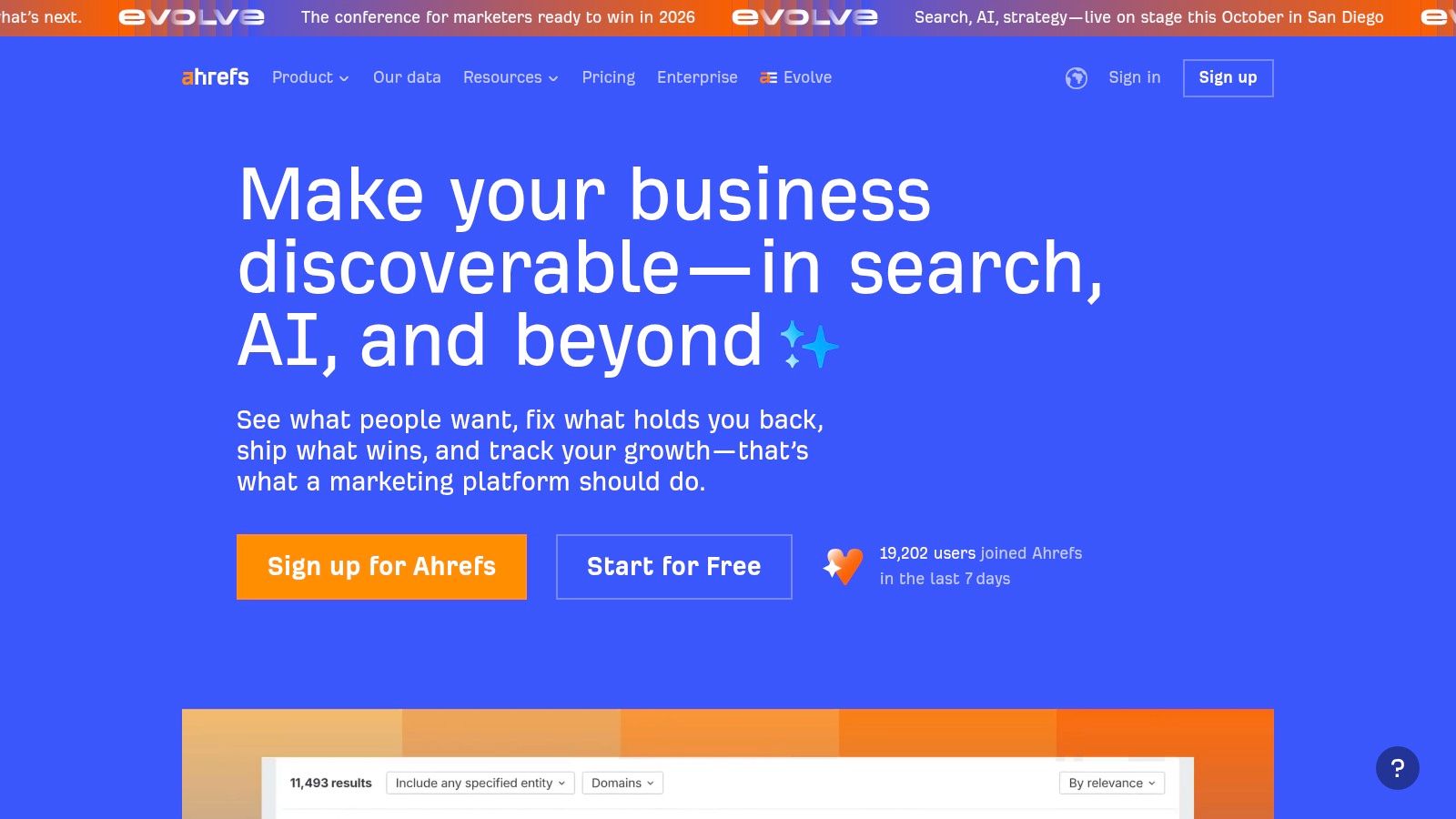
Although direct competitor research is limited on the free plan, you can still gain valuable insights. By understanding your own site's top-performing organic keywords and strongest backlinks through the free tools, you can manually search for these terms on Google to identify and analyse the competitors who are ranking alongside you. This process gives you a clearer picture of who your true digital rivals are.
Key Features & Use Cases
- Site Audit: Use the free Ahrefs Webmaster Tools to find and fix technical SEO issues on your own site, ensuring you have a solid foundation before analysing competitors.
- Backlink Profile Analysis: See who links to your website, identify your most authoritative referring domains, and monitor new and lost backlinks over time.
- Organic Keyword Performance: Discover the keywords your site ranks for, helping you to identify your core organic search competitors for those same terms.
Limitations and Pricing
Ahrefs’ main drawback as a free tool is that comprehensive competitor analysis, such as viewing a rival's complete backlink profile or keyword rankings, requires a paid subscription. There is no traditional free trial for its full suite of tools. The free version is strictly limited to verified websites you own, making it a self-analysis tool rather than a direct competitor intelligence platform. The user interface is data-rich and can feel complex for beginners.
Best For: Businesses serious about SEO who want to establish a strong technical and backlink foundation. It's ideal for auditing your own site to create a benchmark for competitor comparisons. To get the most out of this data, explore our expert insights into advanced SEO strategies.
Website: https://ahrefs.com/
4. Moz
Moz has long been a heavyweight in the SEO world, and its suite of free tools offers significant value for competitor analysis. Its primary strength lies in backlink and authority analysis, providing easy-to-digest metrics that help you quickly evaluate a competitor's SEO standing. Using its free Domain Analysis tool, you can input any competitor's URL and get an instant snapshot of their Domain Authority (DA), top-ranking keywords, and key linking domains. This makes it one of the most effective competitor analysis tools free for understanding the foundations of a rival's search engine performance.
The platform is particularly good at demystifying complex SEO data. Metrics like Domain Authority and Spam Score provide a straightforward way to gauge a site's trustworthiness and authority in Google's eyes, allowing you to benchmark your own site's progress against the competition.
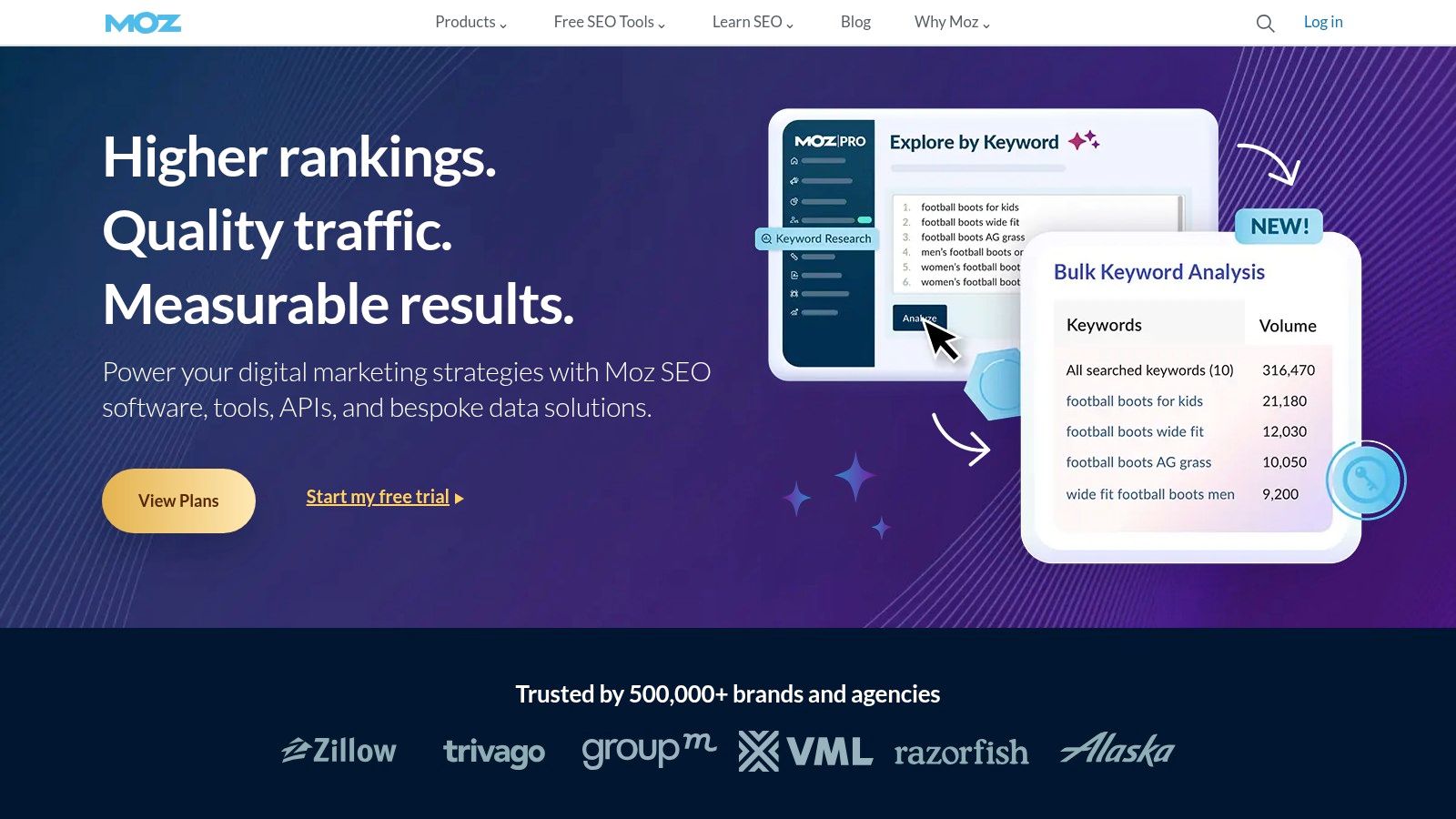
Key Features & Use Cases
- Domain Analysis: Get a quick overview of any domain's authority, linking domains, and top-ranking keywords. Ideal for a high-level SEO health check on your competitors.
- Link Explorer: Analyse a competitor’s backlink profile to see who is linking to them. This is a crucial feature for identifying potential link-building opportunities for your own website.
- Keyword Explorer: Discover the keywords your competitors rank for and identify keyword gaps you could target. The free version provides a limited number of queries per month.
Limitations and Pricing
Moz's free offerings are generous for initial research but are heavily capped. You get a limited number of reports and queries per month, and detailed data exports or extensive historical analysis are locked behind the Moz Pro subscription. While the free tools provide a great starting point, a comprehensive SEO competitor strategy will almost certainly require upgrading to a paid plan for deeper, more actionable insights.
Best For: Businesses focusing on an SEO and link-building strategy. It is excellent for identifying a competitor's most valuable backlinks and understanding their overall domain authority in the market.
Website: https://moz.com/
5. SpyFu
SpyFu is a powerhouse for deconstructing your competitors' search marketing strategies, both paid and organic. Its unique strength lies in its deep historical data, allowing you to see which keywords a competitor has targeted and the ad copy they have used for over a decade. This makes it one of the most insightful competitor analysis tools free for understanding the evolution of a rival's PPC and SEO efforts. The free version provides a generous glimpse into this data, letting you see a competitor's most profitable keywords and top organic rankings without creating an account.
The platform is designed to uncover the "secret formula" of your competitors' search success. You can input any domain and instantly see every keyword they rank for on Google, every ad variation they have tested, and every ad buy they have made. This level of detail is invaluable for reverse-engineering successful campaigns and identifying keyword gaps in your own strategy.
Key Features & Use Cases
- PPC & SEO Keyword Research: See the exact keywords competitors are bidding on in Google Ads and ranking for organically. This is perfect for building your own keyword lists and discovering profitable new terms.
- Competitor Ad History: Analyse years of a competitor's ad copy and campaign changes. Use this to understand their messaging and identify what has worked for them over time.
- "Kombat" Feature: Directly compare your website's keyword profile against two competitors to find common keywords and identify unique opportunities where they rank, but you do not.
Limitations and Pricing
While the free access is useful for spot-checking, it is significantly limited in terms of data exports and the number of results you can view. The full power of SpyFu, including unlimited search results, historical data, and reporting, is locked behind its paid subscriptions. The interface can also feel data-dense for new users, presenting a steeper learning curve than some other tools.
Best For: Digital marketers and SEO/PPC specialists who need granular, historical data on a competitor's search marketing activities. It is ideal for in-depth keyword and ad copy analysis. By using its insights, you can streamline your research processes, which aligns with modern approaches to business process automation.
Website: https://www.spyfu.com/
6. SISTRIX
SISTRIX is a powerful SEO-focused platform renowned for its proprietary Visibility Index, a metric that measures a domain's organic search performance on Google. While it's a comprehensive paid suite, SISTRIX offers a range of valuable competitor analysis tools free of charge, making it an excellent resource for businesses, particularly those operating in the UK and European markets. Its standout feature is the ability to check the Visibility Index for any domain, providing a clear, long term performance benchmark that cuts through the noise of daily ranking fluctuations. This allows you to quickly assess a competitor's historical SEO success and current trajectory without needing to sign up.
The free toolset extends beyond just the index, offering on-demand checks for keyword SERPs, page speed, and even a Google Update Radar. This makes it a highly practical platform for conducting specific, targeted investigations into a competitor's SEO strategy, from understanding their core keywords to evaluating their technical site performance. The interface is data-rich yet straightforward, presenting complex SEO metrics in an accessible way.
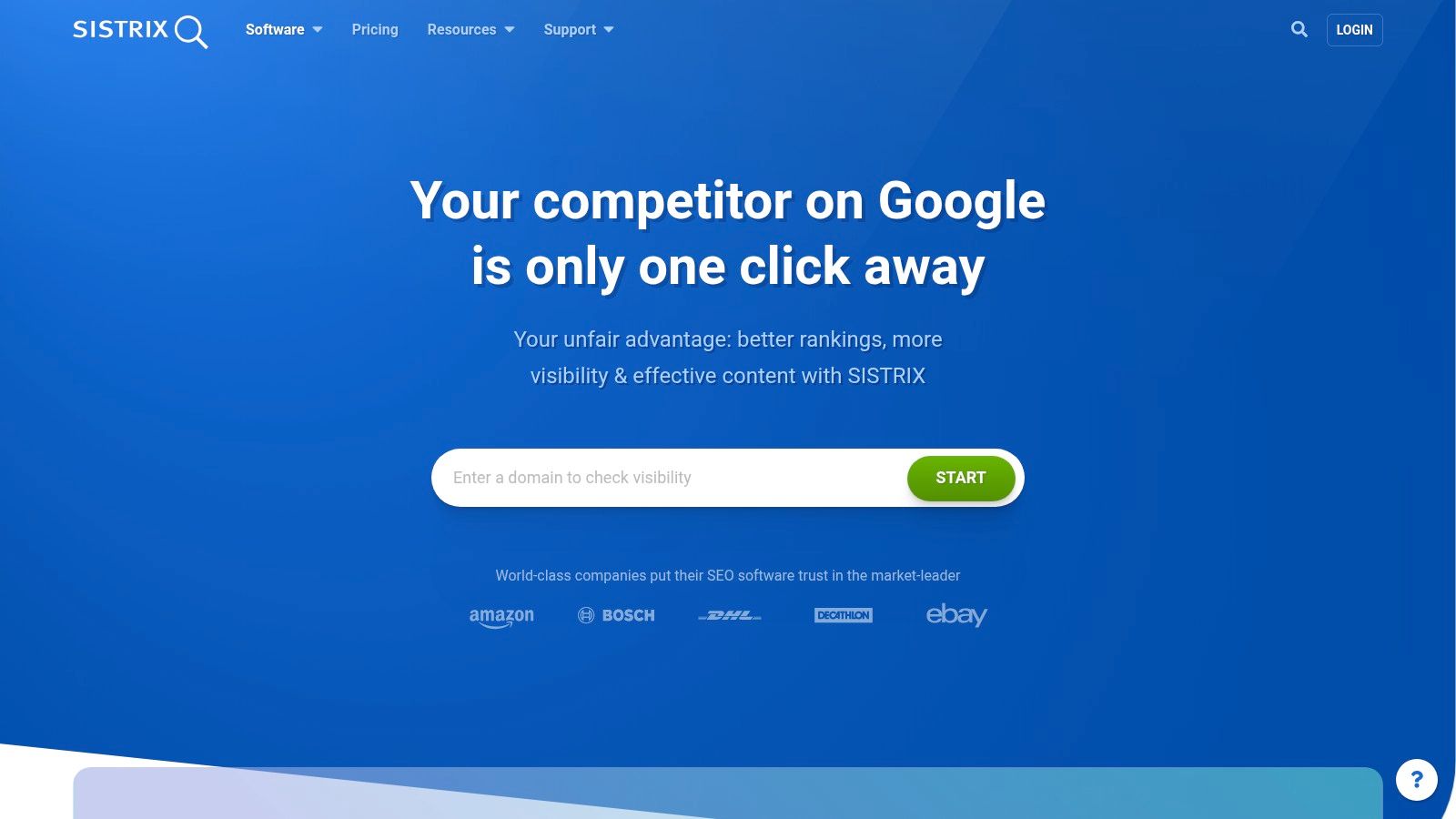
Key Features & Use Cases
- Visibility Index Checker: Instantly measure and compare the historical organic search visibility of your website against key competitors. Ideal for benchmarking SEO performance and identifying long term trends.
- Keyword & SERP Analysis: Analyse the search results for specific keywords in the UK and other international markets. This helps you understand who ranks for your target terms and what their content looks like.
- Free SEO Utilities: Access a suite of tools including a page speed checker and a "for free" version of their core platform. Perfect for quick technical SEO audits on rival sites.
Limitations and Pricing
The free tools are excellent for spot-checks but are intentionally limited to encourage an upgrade. You can only perform a certain number of checks per day, and access to the full range of historical data, backlink profiles, and detailed content analysis is restricted to the paid modules. While several free tools are available, gaining a complete picture requires subscribing to their core platform, which is priced for serious SEO professionals.
Best For: SEO managers and digital marketers who need a reliable, data-driven way to benchmark organic search performance, especially those with a focus on UK and European markets.
Website: https://www.sistrix.com/
7. Google Trends
While not a direct traffic analysis tool, Google Trends is an indispensable and completely free platform for understanding market interest and brand awareness over time. Its core strength lies in revealing the relative popularity of search terms, which can be leveraged to compare your brand's search interest directly against your competitors. You can see how demand fluctuates, identify seasonal patterns, and spot emerging trends in your industry before they become mainstream. This makes it one of the most powerful foundational competitor analysis tools free for market research and strategic planning.
By filtering data specifically for the UK, you can gain a clear picture of how your brand's search popularity stacks up against rivals on home turf. This insight is crucial for gauging brand recall and the impact of marketing campaigns, allowing you to see whose name is generating more curiosity among the public.
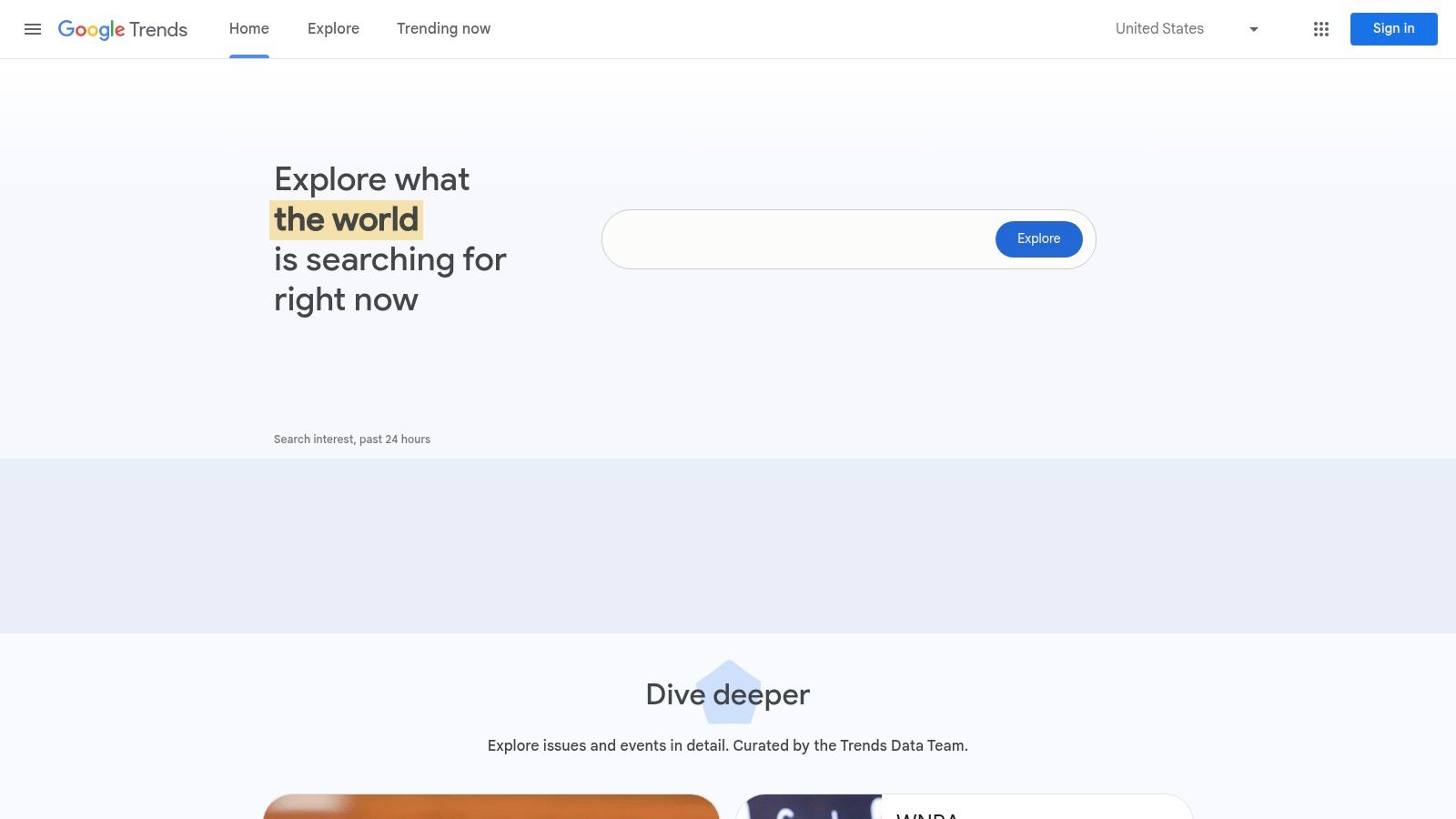
Key Features & Use Cases
- Brand Interest Comparison: Directly compare the search volume interest for your brand name against multiple competitors over a specified period. This is perfect for tracking brand awareness and market share of voice.
- Seasonality & Trend Spotting: Analyse historical search data to identify seasonal peaks and troughs in customer demand for products or services in your sector.
- Related & Rising Queries: Discover what else your target audience is searching for in relation to your competitors. This can uncover new content ideas, keyword opportunities, or unmet customer needs.
Limitations and Pricing
Google Trends is entirely free, with no hidden costs or premium versions. However, its primary limitation is that it shows relative interest on a scale of 0 to 100, not absolute search volume or website traffic numbers. The data is directional and should be used to understand trends and comparisons rather than for precise traffic forecasting. It is also limited exclusively to data from Google Search, offering no insight into other traffic channels.
Best For: Strategic marketers and business planners looking to understand high-level market dynamics, brand popularity, and consumer behaviour trends without needing granular traffic metrics.
Website: https://trends.google.com/
8. Meta Ad Library (Transparency Centre)
Meta's Ad Library is an indispensable resource for understanding your competitors' social advertising strategies on Facebook and Instagram. As a completely free first party database, it provides direct insight into the exact ad creatives, messaging, and formats your rivals are using. You can search by advertiser name or keyword to see all active ads they are running, making it one of the most powerful competitor analysis tools free for social media intelligence. This transparency is particularly strong for UK and EU markets due to regional advertising policies.
The platform allows you to see how competitors are positioning their products, the promotions they are pushing, and the visual styles they are testing. You can analyse their ad copy, calls-to-action, and the landing pages they are directing traffic to. This gives you a real time view of their social media sales funnel and campaign tactics, providing a wealth of inspiration for your own creative development.
Key Features & Use Cases
- Creative & Copy Analysis: View the exact ad creatives (images and videos) and copy your competitors are currently running. This is perfect for dissecting their messaging and value propositions.
- Advertiser Search: Look up any brand to see a comprehensive library of their active ads across all Meta platforms, including Facebook, Instagram, and Messenger.
- Regional Filtering: Filter searches to specific countries, like the UK, to understand how competitors are tailoring their campaigns to different local audiences.
Limitations and Pricing
While the Ad Library is invaluable for creative research, it offers no performance data. You cannot see metrics like engagement, reach, conversions, or ad spend for commercial ads. Its primary focus is on transparency, not performance analytics. The search interface is functional but basic, and detailed historical data is primarily available for ads related to social issues, elections, or politics.
Best For: Social media managers and digital marketers wanting to analyse competitor ad creatives, messaging, and promotional offers on Facebook and Instagram. It’s ideal for campaign planning and creative brainstorming. For deeper insights into effective Meta ad design, explore this comprehensive Meta Ads Creative Guide.
9. Google Ads Transparency Centre
The Google Ads Transparency Centre is an official, searchable hub that provides a direct look into the advertising activities of your competitors across Google's vast ecosystem. Its primary strength is offering first party, unfiltered access to the ads a specific brand is running on Search, YouTube, and the Display Network. This makes it one of the most authoritative competitor analysis tools free for anyone focused on paid advertising, allowing you to see your rivals' creative strategies, messaging, and ad formats without any guesswork.
You can search for any verified advertiser and immediately see a portfolio of their current and past ad campaigns. This is invaluable for understanding how a competitor positions its products, the promotions they are pushing, and the visual styles they employ across different platforms, including a specific focus on the UK market.
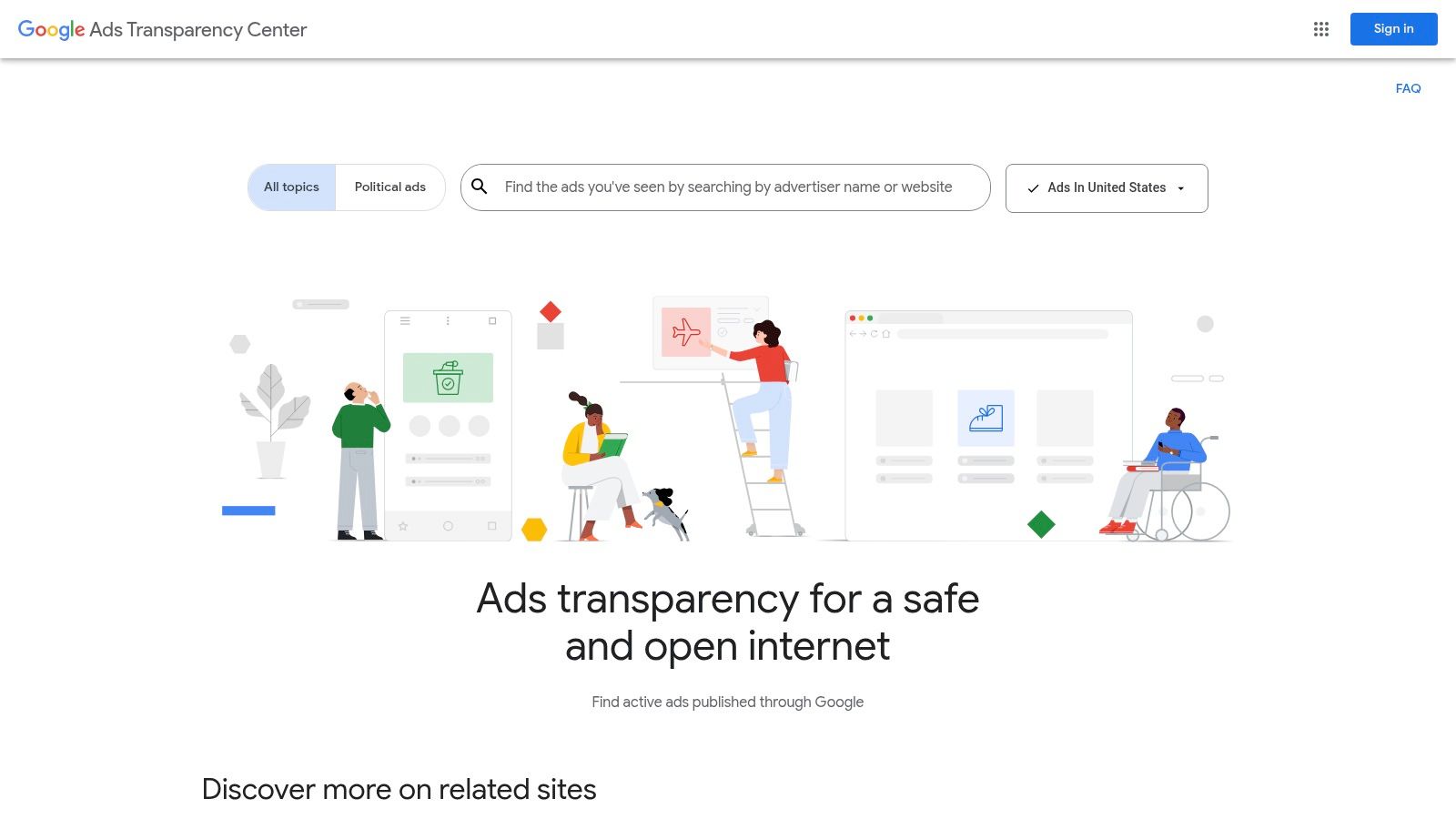
Key Features & Use Cases
- Advertiser Ad Repository: Search for any competitor and view all the ads they have run from a verified Google Ads account. This is ideal for analysing messaging, calls to action, and creative angles.
- Multi-Format Ad Viewing: See the exact creative variations a competitor uses across different formats like text ads, image-based display ads, and video ads for YouTube.
- Basic Ad Context: The platform shows when an ad was last seen and the format it appeared in, giving you a general sense of campaign timing and focus.
Limitations and Pricing
As a free transparency initiative, the tool is entirely focused on the ads themselves and lacks any performance data. You will not find information on budgets, targeting criteria, click-through rates, or conversion metrics. The interface is built for research, not deep analysis, and lacks features for exporting data or generating reports, requiring you to manually collect insights.
Best For: PPC managers, marketing teams, and brand strategists who need to analyse competitor ad creatives and messaging directly from the source. It is perfect for creative brainstorming and understanding a rival's promotional calendar.
Website: https://adstransparency.google.com/
10. BuiltWith
BuiltWith offers a unique angle on competitor analysis by focusing on the technology stack behind a website. Rather than traffic metrics, it tells you what platform a competitor's site is built on (e.g., Shopify, WordPress), what analytics they use (e.g., Google Analytics, Hotjar), and even their advertising and payment solutions. This provides a deep technical insight into their operational infrastructure, revealing their investments in marketing, sales, and e-commerce technology. As one of the more specialised competitor analysis tools free for this purpose, it is invaluable for understanding the sophistication of a rival's digital setup.
The free version allows you to look up individual websites on demand, generating a comprehensive report of their entire tech stack. This is perfect for targeted research, helping you identify if a successful competitor is using a particular CRM, marketing automation tool, or customer support plugin that could be giving them an edge. The platform’s interface is straightforward and data-centric, presenting the information in clear, categorised lists.
Key Features & Use Cases
- Technology Profiling: Instantly discover the CMS, analytics tools, widgets, and advertising networks used by any competitor. This is ideal for technology benchmarking and finding new tools for your own stack.
- Historical Tech Data: See which technologies a website has used in the past. This can reveal strategic shifts, such as moving from one e-commerce platform to another.
- Lead Generation (Paid): The platform can generate lists of websites using specific technologies, which is a powerful feature for B2B sales and marketing teams.
Limitations and Pricing
The free lookup is excellent for single-site analysis, but its true power is locked behind paid plans. Bulk lookups, detailed data exports, trend analysis, and lead generation capabilities all require a subscription. Furthermore, while its detection is generally accurate for popular technologies, it may occasionally misidentify or miss very niche or custom built tools.
Best For: Tech-savvy marketers, web developers, and B2B sales teams who need to understand a competitor's technical infrastructure or identify sales leads based on technology usage.
Website: https://builtwith.com/
11. Wappalyzer
Wappalyzer is a powerful technology profiler that offers a different angle on competitor analysis. Instead of looking at traffic, it tells you what software and tools a website is built with. Its strength is in revealing the technological foundation of a competitor's digital presence, from their content management system and e-commerce platform to their analytics tools and advertising networks. This makes it one of the most insightful competitor analysis tools free for understanding the operational side of a rival's business.
The free browser extension is incredibly convenient, allowing you to instantly see a site's tech stack with a single click as you browse. For UK businesses planning a website build or platform migration, this is an excellent way to see what technologies successful competitors are using to power their sites, providing a blueprint for your own tech stack decisions.
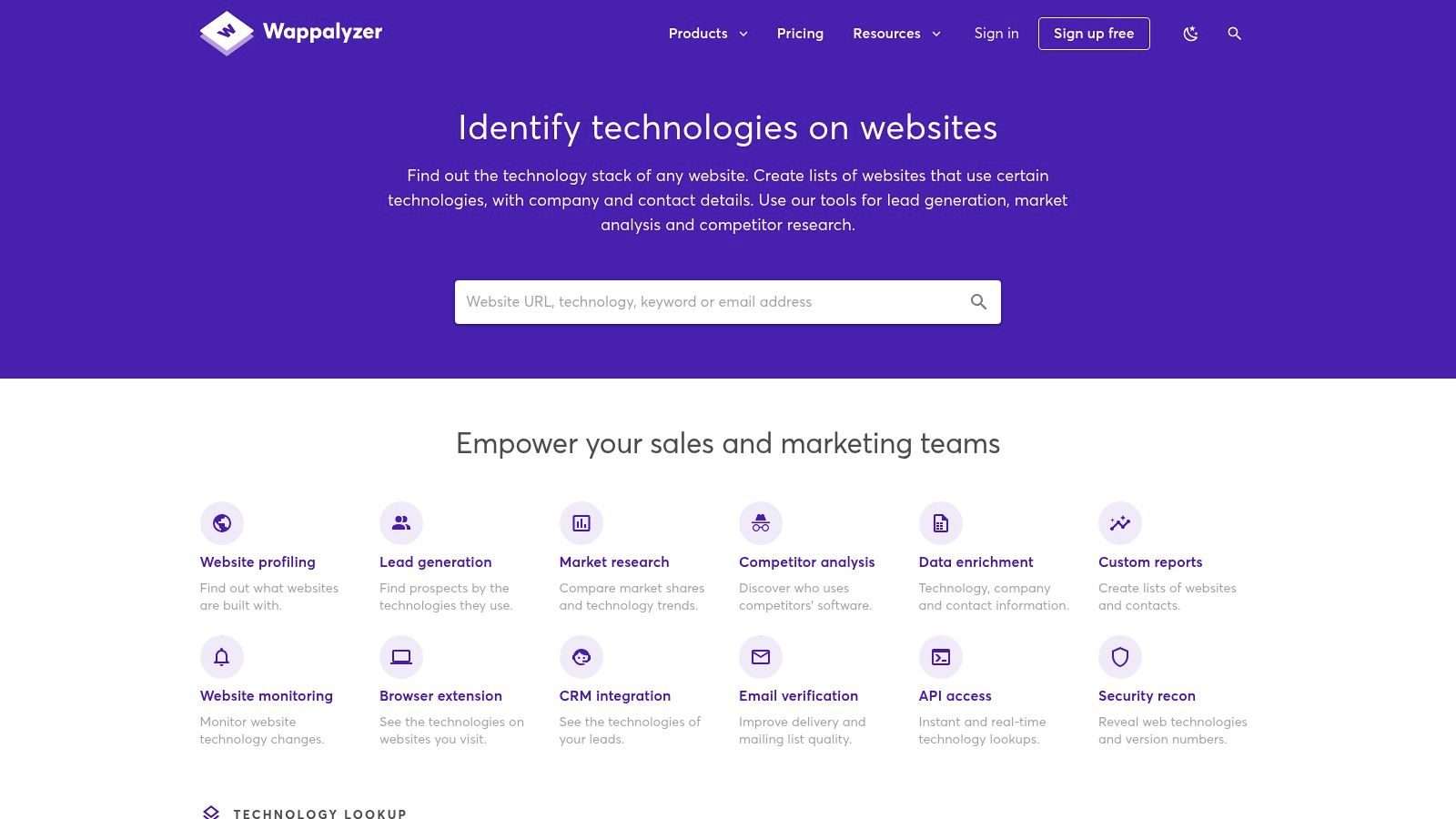
Key Features & Use Cases
- Technology Profiling: Instantly identify the CMS, frameworks, analytics tools, and marketing software used on any website. This is perfect for tech reconnaissance.
- Browser Extension: Get on-the-fly tech stack information directly in your browser without needing to visit the Wappalyzer site, streamlining your research process.
- Lead Generation Lists: While a paid feature, the ability to build lists of websites using specific technologies can help you identify new competitors or potential sales leads.
Limitations and Pricing
The core technology lookup feature is generous, but the free plan has limitations. You receive a free quota of 50 lookups per month on their website, which may not be enough for extensive research. More advanced features like company data enrichment, contact information, and bulk analysis are gated behind paid subscriptions. The user interface is clean and functional, but its primary purpose is data delivery rather than deep analysis.
Best For: Developers, technical marketers, and SaaS companies wanting to understand the technology stack of competitors. It's invaluable for technical benchmarking and identifying sales opportunities based on software usage.
Website: https://www.wappalyzer.com/
12. Owler
Owler shifts the focus from website traffic metrics to corporate intelligence, providing real time news, alerts, and company updates. It excels at keeping you informed about your competitors' business activities, such as funding announcements, acquisitions, leadership changes, and major press coverage. This makes it one of the most practical competitor analysis tools free for staying ahead of market-moving news without having to constantly scour the web yourself. You can follow specific companies and receive curated updates directly to your inbox.
For UK businesses, this is a simple yet effective way to monitor the strategic manoeuvres of domestic rivals. Instead of analysing past performance data, Owler helps you track their present and future plans as they are announced, offering a qualitative layer to your competitive research that quantitative tools often miss.
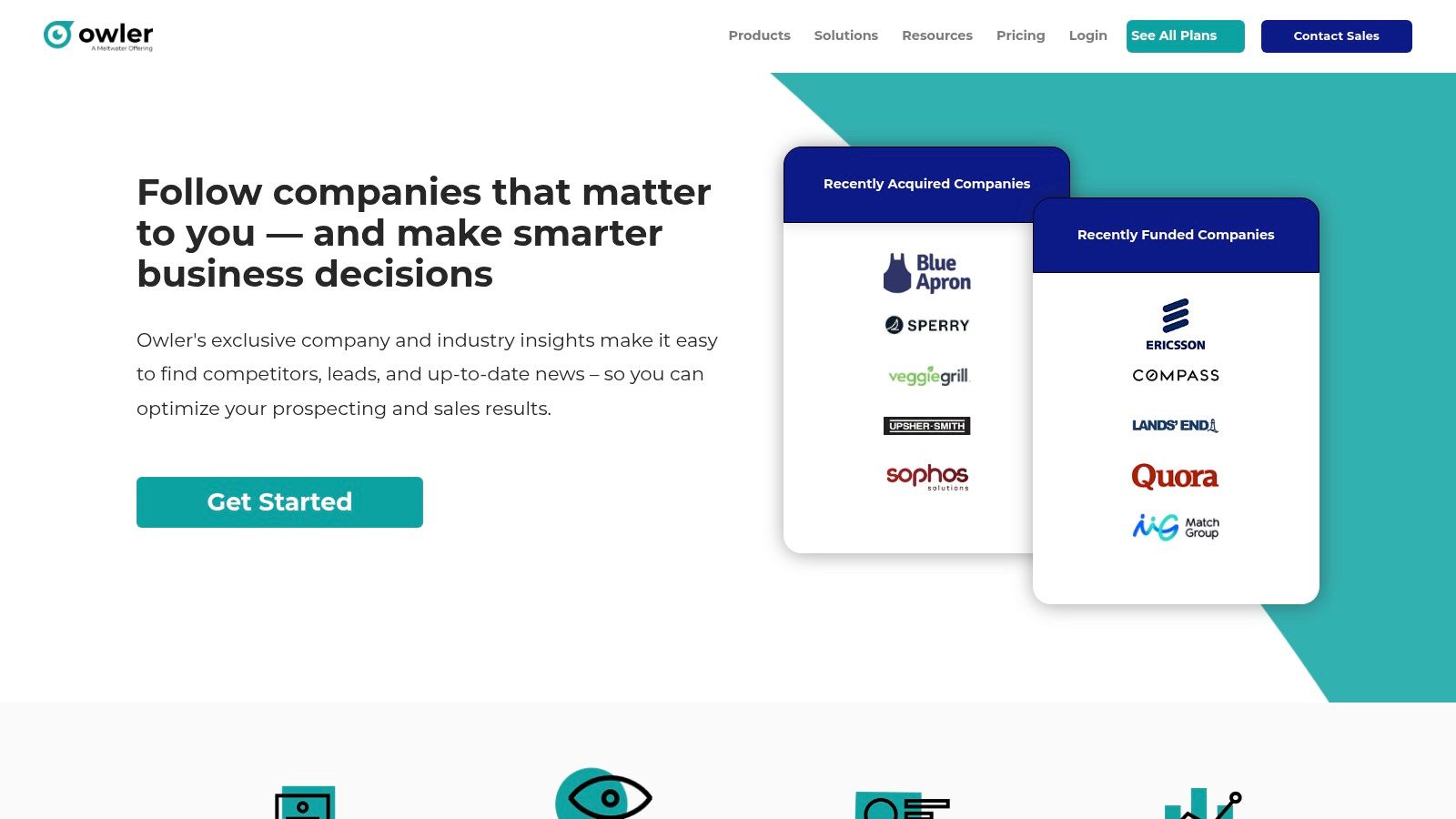
Key Features & Use Cases
- Company Newsfeeds: Get a curated feed of the latest news, press releases, and blog posts for any competitor you follow. Ideal for keeping a finger on the pulse of their public relations and marketing strategy.
- Email Alerts: Receive a "Daily Snapshot" summarising the top news from the companies you track. This is perfect for busy founders and marketing managers who need quick, digestible updates.
- Competitor Discovery: The platform suggests competitors based on industry and profile, helping you identify rivals you may not have been aware of.
Limitations and Pricing
Owler operates on a freemium model. The free "Community" tier is useful but comes with strict limits on how many companies you can follow (up to 5) and how many company profiles you can view per month. To unlock unlimited following, advanced search filters, and deeper company data, you need to subscribe to their paid plans, which are geared towards sales and corporate teams.
Best For: Professionals who need to monitor competitors' corporate and public relations activities. It is an excellent, low-effort tool for staying informed on strategic business developments rather than granular marketing metrics.
Website: https://www.owler.com/
Free Competitor Analysis Tools Comparison
| Tool | Core Features ✨ | User Experience ★★★★☆ | Value Proposition 💰 | Target Audience 👥 | Unique Selling Points 🏆 | Price Points 💰 |
|---|---|---|---|---|---|---|
| Similarweb | Traffic insights, channel mix, geo data, browser extension | Quick insights, easy competitor snapshots | Free limited data; paid for detailed analysis | Digital marketers, researchers | Robust UK geographic filtering, fast extension | Free tier; paid upgrades |
| Semrush | SEO, PPC, keyword & backlink analytics, site audits | Comprehensive all in one platform for teams | Generous free account; premium toolkits | SEO pros, agencies, teams | Strong UK data, single-login convenience | Free + paid plans |
| Ahrefs | Backlink profiles, keyword explorer, site audit | High-quality backlink data, useful free tier | Free for owned domains; paid for full features | SEO specialists, businesses | Large historical link data, backlink focus | Paid plans; limited free tier |
| Moz | Link analysis, keyword research, rank tracking | Easy metrics like Domain Authority | Free domain analysis; paid Pro for advanced use | SEO beginners, small businesses | User-friendly SEO metrics | Free + paid Pro plans |
| SpyFu | PPC & SEO keyword history, rank tracking, ad analysis | Data-dense interface, steep learning curve | Strong PPC insights; money-back guarantee | PPC managers, SEO analysts | Historical PPC data and competitor Kombat | Limited free; paid required |
| SISTRIX | Visibility Index, UK/EU SEO tools, page speed checks | Free SEO tools without sign-up | Free utilities; paid advanced modules | SEO analysts, UK/EU marketers | Proprietary visibility index | Free with paid modules |
| Google Trends | Search interest over time, related topics, UK filters | Fast, reliable trend detection | Completely free | Marketers, researchers | Real time search interest, free | Free |
| Meta Ad Library | Search Facebook/Instagram ads by advertiser ®gion | First party ad creatives, no performance metrics | Free access to up-to-date ad creatives | Social media marketers | Comprehensive FB/IG ad transparency | Free |
| Google Ads Transparency | Search Google ads by advertiser & geography | Multi-platform ad view, research-oriented | First party ad transparency across Google | Advertisers, market analysts | Cross-format ad insights | Free |
| BuiltWith | Tech stack profiling, historical trends | Quick individual lookups; bulk needs paid plans | Free single reports; paid exports | Web developers, marketers | Extensive tech usage history | Free + paid plans |
| Wappalyzer | Browser extension tech detection, API, enrichment | User-friendly extension and quota-limited free use | Free monthly lookups; paid for bulk/enrichment | Developers, marketers | Easy quick tech detection | Free + paid plans |
| Owler | Company profiles, newsfeeds, email alerts | Simple competitor monitoring | Freemium; paid for unlimited follows and alerts | Business managers, analysts | Curated news, daily snapshots | Free community + paid plans |
Final Thoughts
Embarking on competitor analysis can seem like a monumental task, especially when faced with budgetary constraints. However, as we have explored, a wealth of high-calibre competitor analysis tools free of charge are readily available. These platforms dismantle the barrier to entry, empowering businesses of any size, from agile startups to established enterprises, to gather sophisticated market intelligence without a significant financial outlay. We have journeyed through a dozen powerful tools, from the comprehensive web traffic insights of Similarweb to the technological deep dives offered by BuiltWith and Wappalyzer.
The core takeaway is that a "free" tool does not equate to a "basic" or ineffective one. The freemium models offered by giants like Semrush, Ahrefs, and Moz provide a substantial taste of enterprise-level data, perfect for focused research projects. Meanwhile, platforms like Google Trends and the Meta Ad Library offer unfiltered, direct-from-the-source insights into market behaviour and competitor advertising strategies, which are invaluable for real time adjustments to your own campaigns.
From Data Points to Strategic Decisions
The true power of these free competitor analysis tools lies not just in the data they provide, but in how you synthesise and act upon it. A scattergun approach, dipping into multiple platforms without a clear objective, will only lead to a confusing mass of metrics. The key is to adopt a structured and strategic methodology. Before you even open a new browser tab, define what you need to know. Are you reverse-engineering a rival’s SEO success, dissecting their social media advertising, or understanding the technology stack that powers their user experience?
Once your objective is clear, you can build a customised "toolkit" from the options discussed. For instance:
- For SEO Keyword Gaps: Start with the free tiers of Semrush or Ahrefs to identify your rivals' top-ranking keywords, then use SpyFu to find keywords they rank for but you do not.
- For Content Strategy: Use Google Trends to spot rising topics in your industry, then analyse how top competitors are covering these subjects using Similarweb to see which of their pages attract the most traffic.
- For Advertising Intelligence: Combine insights from the Meta Ad Library and Google Ads Transparency Centre to get a panoramic view of your competitors' creative messaging and promotional offers across the two largest digital advertising ecosystems.
- For Technical Benchmarking: Use BuiltWith or Wappalyzer to quickly assess if a competitor is using a specific e-commerce platform, analytics tool, or CRM that might be giving them an operational edge.
Choosing and Implementing Your Free Toolkit
Selecting the right combination of tools is a process of matching capability to need. A B2B service company may find more value in Owler's corporate insights and Semrush's keyword data, while a direct-to-consumer e-commerce brand might lean more heavily on the Meta Ad Library and Similarweb to understand traffic sources and social advertising funnels.
Remember the limitations. Free versions often come with daily query limits, restricted data sets, or fewer features than their paid counterparts. This is not a deterrent but a call for focus. Maximise your daily allowances by planning your research in advance. Use these tools for targeted, high-impact queries rather than broad, exploratory searches. The constraints of a free plan can actually enforce a more disciplined and efficient approach to analysis.
Ultimately, the goal is to transform observation into action. The insights you gather should directly inform your marketing strategy, product development, and overall business positioning. By consistently monitoring the competitive landscape with these powerful and accessible competitor analysis tools free of charge, you equip your organisation with the foresight needed to not just compete, but to lead in your market.
Feeling overwhelmed by the data and unsure how to turn these insights into a cohesive marketing strategy? Superhub acts as your outsourced marketing department, translating complex competitor analysis into actionable campaigns that drive growth. Let us handle the data synthesis and execution so you can focus on running your business; learn more at Superhub.





